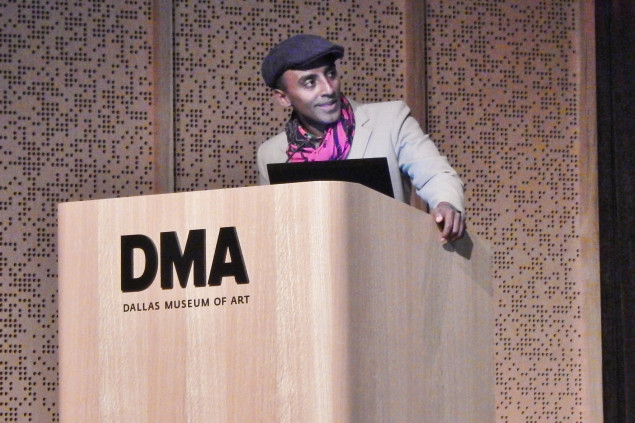
Before his talk last Friday at the Dallas Museum of Art, I had seven minutes in the Green Room with chef Marcus Samuelsson, the wunderkind chef who’s won James Beard awards for Rising Star Chef and Best Chef, New York City and whose books have been equally lauded. He’d spent the afternoon in Deep Ellum, and yes, he’d eaten at Pecan Lodge. But his find of the day was something he’d unearthed in Lula B’s rabbit-warren of vintage consignment as he gathered final décor elements for Streetbird, the restaurant he’s opening in Harlem near his famous Red Rooster. The object in question: A STOP sign someone had shot through. “New York would never have that,” he said, “I have to come here to find that.” What he loved about Lula B’s speaks to his penchants as much as the lingonberry gougeres and piri-piri shrimp served at the DMA’s pre-lecture dinner, where a slideshow drew connections between selected artwork and Samuelsson’s globally-minded dishes. “Everything they have [at Lula B’s], there’s a story,” he said. “And I want that.”
Samuelsson is a storyteller. His latest cookbook Off-Duty: The Recipes I Cook At Home, which he was in town to promote, is heavy on the personal. The recipes reflect his roots in Ethiopia and Sweden, but also the way his peregrinations have added layers. During his talk, stories came in swaths—stories about his mother walking the long road to Addis Abeba with her children, her bags packed with chickpeas for sustenance (“When I pop chickpea snacks,” Samuelsson said, “I think, ‘I lived because of you!’ They’re also part of the next solution. A big part of the world lives on chickpeas.”). There were stories about fishing for mackerel with his uncle in Sweden; about a disastrous Swedish state dinner when no ovens were working.
The audience matched his authenticity and energy. He got recommendations for where to find good fried chicken (“Rudy’s in South Oak Cliff!”).

But what made it more than an evening of storytelling was something else, a deeper message, more important to me, for us, for Dallas. Samuelsson presents a case study in what it means—and the effort it takes—to be rooted in community. In his case, the place is Harlem, which “saved him,” he says. Harlem, where five years ago he opened Red Rooster, whose vibrancy and refined takes on comfort food exerted a gravitational pull. It was jazzy and polished, a beautifully executed concept. But more than that, it felt tapped into place.
In what ways are chefs responsible for the vitality and life of a neighborhood? I asked him. In what ways can they do things others, perhaps, can’t?
My mind goes immediately to Oak Cliff. New restaurants, chefs sensitive to the power of community. Some people want to be having the conversation. Are we going as deep as we could be? There is always a danger of mere imitation, of capitalizing on a trend.
“It took me five years to understand Harlem,” Samuelsson said. “I wanted to understand the community before me, right before me, and also the past and the future.” He put in library time, researched the neighborhood’s history and culture. “Each chef does it differently.”
Samuelsson knew he was going into an urban environment with deep food needs, certainly beyond the purview of his restaurant. There was no farmers market. The conversations that finally brought about such a market raised questions about the meaning of local. There would be vegetables. “But what vegetables?” It was one thing to prioritize New-York-grown produce. “But you also have to be relevant in that local community,” Samuelsson said. So plantains. Because a farmers market in a neighborhood with a large Puerto Rican population would be less locally relevant without them. There’s humility in that stance. A willingness to acknowledge that places are layered, and that understanding them must be as well. What has a neighborhood been, who has lived there, what has that meant, who lives there now—and where is it going?

I like the small way that sensitivity plays out in the reservation system at Red Rooster. Early on, Samuelsson realized that a traditional reservation system was skewing the clientele. He created a system where one-third of reservations are taken by phone (the New Yorker); one-third online (the out-of-towner); one third walk-in (the Harlem-dweller). It shifted the dynamic, he said. What’s most significant to me is the thought that went into it. This fine-tuned calibration that reflects a commitment. If something is a priority, how do you make sure it’s reflected in your restaurant?
“I think it’s the most challenging and exciting time in food,” Samuelsson said. He objects to a model where dining is defined by European standards, classic French. The message, as he put it, was that “when it comes to the table, all of a sudden we’re supposed to forget the food we grew up with. What I find so exciting about this time is that all of that is going away.” It’s a time to think about what we’re doing, why, and for whom.
This is just one set of questions and answers, for one restaurateur in one place. But I think Samuelsson’s experience gives us things to chew on. What might that mean for Dallas? I think we’re figuring it out. What he offers is a vision of how to draw diners through restaurants that are deeply rooted in neighborhood and responsive to place. That’s part of what I took him to mean when he referred to the B-sides, restaurants that feel like “being in on a secret, when the food is like home and you’re in on a secret because it’s that good.” “Go to the B-sides,” he said. “Stay at the B-sides.”






